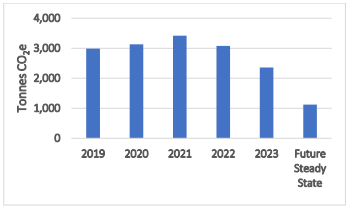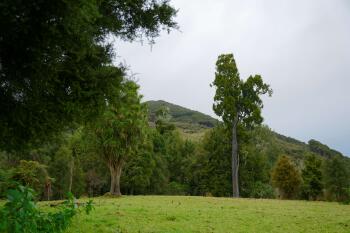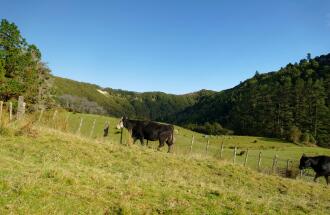Anewa Station, Wairoa
Anewa Station is an Ahu Whenua Trust with six trustees, over 5,000 beneficiaries and a 100-year vision for the land. The trustees have been working to introduce a mosaic of land uses to minimise the impact on te taiao and provide options for future generations. Along the way, they're bringing down their greenhouse gas emissions.
Video
Download this story
Download a copy of the Anewa Station story here [PDF, 722 KB] .
About Anewa Station
Anewa Station is a hill country property inland and northeast of Wairoa. It is an Ahu Whenua Trust, returned to its owners in 1989. Six trustees make decisions for the whenua on behalf of over 5,000 beneficiaries and guided by a 100-year plan.
The farm is 1,942ha of which just under half (960ha) is in pasture for sheep and beef and the rest is in native bush (964ha) and pine forest (18ha). Approximately 27% of the property is steep to very steep hill country.
Table 1 shows the capital stock numbers and overall stocking rate for the farm in recent years and the planned future state.
Table 1: Anewa stock numbers and rate since 2019, including planned future state.
| Area in pasture (ha) | Breeding ewes | Breeding cows | SU/ha | |
| 2019 | 960 | 3,886 | 294 | 9.0 |
| 2020 | 960 | 4,150 | 378 | 9.4 |
| 2021 | 960 | 4,354 | 378 | 10.3 |
| 2022 | 960 | 2,800 | 250 | 9.8 |
| 2023 | 960 | 2,800 | 250 | 7.6 |
| Future | 1,100 | 3,210 | 286 | 7.5 |
GHG numbers
Total biological greenhouse gas emissions across Anewa Station have decreased by 16% since 2019, and 26% since the peak in 2021, as shown in the table below.
Table 2: Anewa Station gross greenhouse gas (tonnes)
|
Methane TCO2e/ha |
Nitrous oxide TCO2e/ha |
Total GHGs/ha TCO2e/ha |
Total GHGs TCO2e |
|
| 2019 | 2.54 | 0.57 | 3.11 | 2,986 |
| 2020 | 2.66 | 0.60 | 3.26 | 3,130 |
| 2021 | 2.91 | 0.65 | 3.56 | 3,418 |
| 2022 | 2.75 | 0.62 | 3.37 | 3,235 |
| 2023 | 2.14 | 0.48 | 2.62 | 2,515 |
| Future | 2.11 | 0.47 | 2.58 | 2,838 |
Table 2 shows an increase in total gross greenhouse gas emissions as stock numbers increased from 2019 to 2021, and a decrease since. The 'Future' scenario involving a greater area of pasture and more stock, while having a similar per hectare greenhouse gas level, has greater total emissions. The trustees' intention is to utilise regenerating native bush areas to offset the farm's emissions. This is shown in Figure 1.

Figure 1: Net GHG emissions (TCO2e)
The farm was modelled in Farmax for the six years being analysed. To find out more about this tool and others, see our Know Your Numbers page.
On-farm actions
Since 2021, a number of changes have been made that have led to a reduction in greenhouse gas emissions:
- Retirement of land to allow native bush to fully regenerate
- Reduced capital stock and improvements to productivity
- Improvement of pasture quality
- Reduced fertiliser use
As can be seen in Table 1, stock numbers on Anewa peaked in 2021. At the end of that year, the trustees retired an area of 320ha of regenerating native bush and began replanting within it. Since then, 246ha of this area has been entered into the Emissions Trading Scheme (ETS) to earn carbon credits. A planting programme with a focus on mānuka and tōtara is underway.

Pasture and regenerating native bush at Anewa (Photo: Dave Allen Photography)
Prior to this, the trustees had protected reserves of 595ha and formally protected 295ha as a Māori reservation under Te Ture Whenua Māori Act.
Since 2021, the trustees have also adopted a policy of reduced capital stock, improved productivity and endeavouring to sell animals prime rather than store.
"We are focusing production on the best land classes," says Hilton Collier, Anewa Trustee. "This has meant having the courage to accept that you don't have to have livestock on every last hectare."
In addition to the stock changes, the team at Anewa have also been undertaking a significant amount of fencing, including waterways and subdivision fencing. This supports improvements in animal productivity and has also meant that inputs such as fertiliser are used more effectively.
To read more about on-farm actions to reduce agricultural greenhouse gas emissions, see our Current Actions page.
What led to the changes?
The trustees wanted to increase the profitability of the farm, reduce its impact on te taiao, and enhance the land and waterways. They also wanted to make sure the farm was sequestering more emissions than it was creating.
A detailed farm plan, with farm-scale soil and Land Use Capability mapping, was developed. This identified areas of the farm best suited to retirement and those that could perform better from a livestock perspective. A reduction in capital stock numbers was agreed and excess stock sold.
Funding was sought from the One Billion Trees and Jobs For Nature programmes to assist with retiring and regenerating the native areas and supporting a riparian retirement fencing project.
What future changes are planned?
Future plans include bringing some semi-developed land into pasture (as shown in Table 1). While this will increase stock numbers, overall stocking rate per hectare will be held at present levels. The trustees also intend to improve areas of poor pasture species into more productive species.
Some may consider this controversial. However, a strong focus of this development will be to ensure that the farm is sustainable and that these changes do not compromise the land and water resource. The need for development for future generations needs to be balanced with emissions and other pressures such as managing water quality and financial returns.
The farm has other areas of regenerating native bush that would be eligible for ETS registration, thereby generating further carbon credits and reducing net emissions even further.

Mosaic of land uses at Anewa Station (Photo: Dave Allen Photography)
The trustees are also exploring opportunities for rongoā Māori and looking at selective tōtara harvest as a craft resource for carvers.
"The idea is to create a mosaic of land uses that are in harmony with te taiao and the values of the owners," says Richard Allen, Anewa Trustee. "We also want to make sure that the platform enables future generations to have options."
The team at Anewa will also continue to work on improvements in productivity and per animal production. Utilising data to provide insights into the management of aniamsl throughout the year will be a key part of this.
Advice for other farmers
Anewa's trustees encourage other hill country farmers to see their farms as diverse landscapes rather than homogenous sheep and beef farms.
There is value in taking the time to identify different areas of land - the poorer performing areas through to the best performing areas. Shifting the focus to profit/ha helps to identify where areas might be costing the business and could be taken out of pastoral production and used for carbon sequestration opportunities. This can also lead to improved performance on the better areas and simplify management as well.
Know your numbers and have a plan
By now, all farmers and growers must have a record of their annual on-farm greenhouse gas emissions (methane and nitrous oxide). By the end of 2024, they'll also need to have a written plan in place to manage them. These requirements are part of the He Waka Eke Noa partnership and are intended to help get farmers ready for agricultural greenhouse gas emissions to be priced from 2025. To find out more on how to do this, see our Know Your Numbers page.

